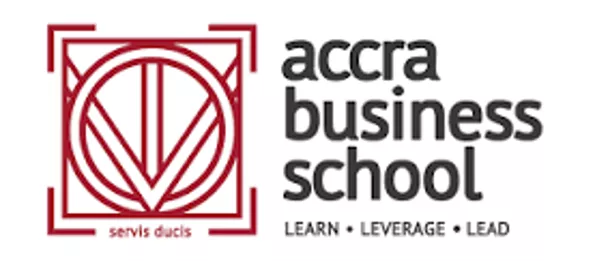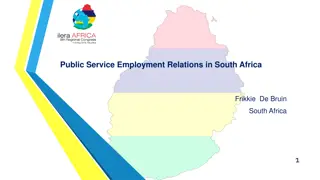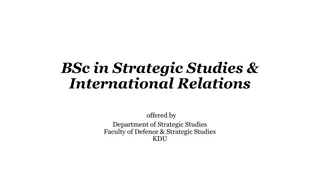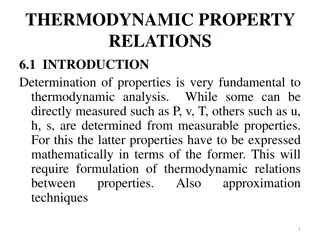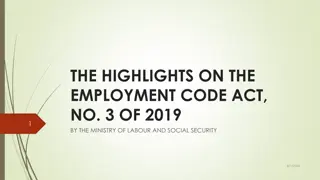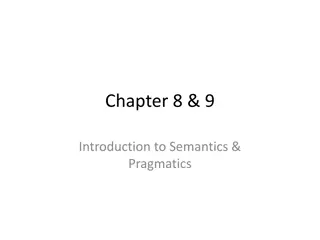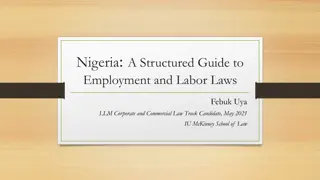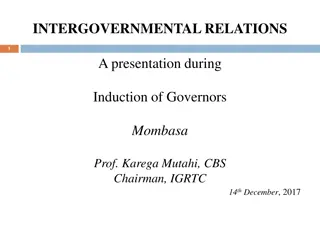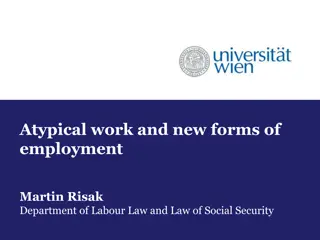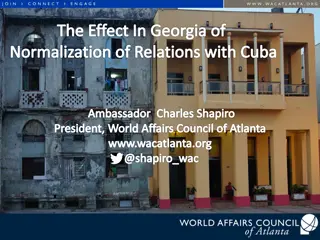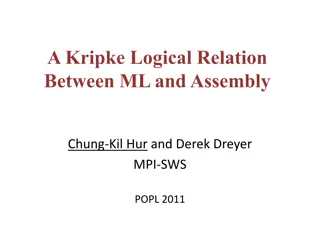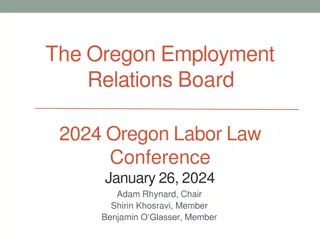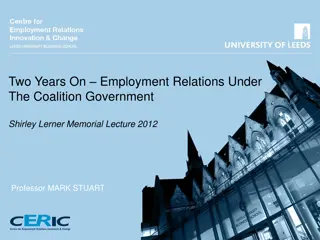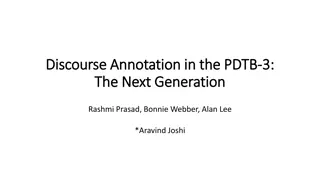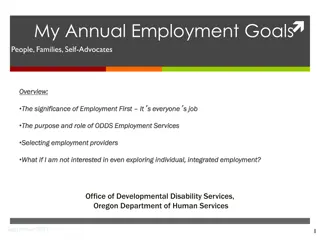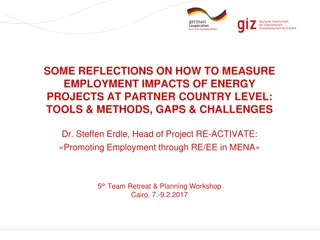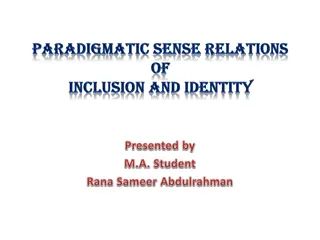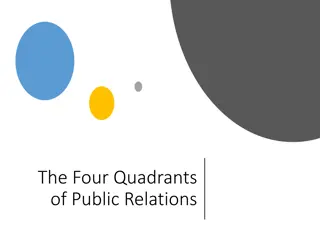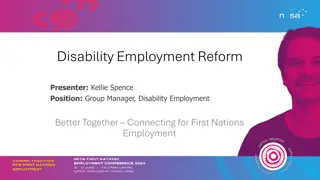Understanding Contemporary Employment Relations: An Overview
This course on contemporary employment relations delves into the history, importance, and impact of employee-employer relationships in the context of Ghana and beyond. Students will explore various aspects of employment relations, including labor market trends, legislation, dispute resolution, ethical practices, and employee voice. The course aims to provide a comprehensive understanding of the complexities surrounding modern employment dynamics.
Download Presentation

Please find below an Image/Link to download the presentation.
The content on the website is provided AS IS for your information and personal use only. It may not be sold, licensed, or shared on other websites without obtaining consent from the author. Download presentation by click this link. If you encounter any issues during the download, it is possible that the publisher has removed the file from their server.
E N D
Presentation Transcript
Course: Contemporary Employment Relations Course Code:MHR 552
House keeping Name Profession Place of work Hobby
Assessment Class Participation (5%) Group work (15%) Assignment (20%) End of Semester Exams (60%)
GWQs 1. Explain the concept of with regards to employment in Ghana. a) What are the importance of this phenomenon ? a) Give your opinion regarding the possible effects of its application in the Ghanaian context (15 Marks)
Why this course? Employee-employer relationship is vital to the success of any company or business (Kar, Sharma, & Borah, 2011). Provide greater perspectives and insight into employment relations practices Contributes to knowledge about ER
Learning Outcomes After studying this course the student should; 1. Understand and critically evaluate competing approaches that contextualise development in employment relations 2. Understand and apply contemporary labour market trends and data specifically examining exploitative relationships; 3. Understand the main sources of employment relations legislation and developments in alternative dispute resolution; 4. Demonstrate and apply knowledge of ethical and legal principles and practices in analysing and responding to business issues; 5. Understand and critically evaluate the role of the parties that affect the management of employment relationships; 6. Understand evaluate contemporary developments in employee voice.
History of Employment Relations Long history of industrial unrest profit maximization suppression of labour Friction between actors Grew out of the need to protect the common interest of workers Classical Industrial Relations Theory (1890s to 1980s) organized labor furthered its goals through collective bargaining, legal enactment, and mutual insurance.
Contd The neo-classical theorists give attention to how labour markets operate and how market forces work to determine wages and as well as the acquisition and use of labour, which reflects the behaviour of profit- maximising entrepreneurs within highly competitive market structures Post-Transformation Employment Relations Theory (1980s to early 2000s) This shift in focus is reflected in changing nomenclature in the field from industrial relations to labor and employment relations, along with aspirations to develop a more generally applicable body of employment relations theory for the present era.
Brief History . Let's take a brief look at history: For many years, ther have been some form of bargain and negotiation around the relationship between employers and their employees. As we moved into the 1800s Industrial Revolution, large companies began to employ vast numbers of people, craftsmen and lower- skilled workers in mills and forges and on highly repetitive production lines in factories. The move from farming to factories and city living gave us the earliest forms of the capitalist system we now know. Wealth acquisition came from industrial strength, not the privilege of birth into the upper classes.
Contd-conditions of work With pressures to keep costs low, production and quality high, plus make profits, industrialists began to push people with longer hours, shortcuts on safety, and disregard for worker welfare People would be exhausted, ill, dismissed, or even died because of poor conditions in those working environments. And so collective worker responses were needed to fight injustice through forms of protest or the ultimate withdrawal of labor. We'd now refer to them as walkouts or strikes.
Contd-legal framework Employment law followed with pressure put on governments to legislate, which continues to this day. Workplace wrongdoing, such as employers discriminating against women or older workers in promotion decisions, would become punishable by law, with the state now able to prosecute businesses and owners whilst giving worker representatives legal force to back their claims of unfair treatment and conditions. This led the way to the development of initially industrial relations, what we now know as employee relations Employment legislation is aimed at giving workers protection, avoiding union disputes.
Contd-unionism The 20th-century workplace history describes a range of industrial disputes covering working time regulations to fair pay and benefits. The 1970s and 1980s were peak unionization period, but this changed in the 1990s with a significant decrease in union power. The decrease of union power continues to now. In present times, large scale disputes are rare and often resolved through mediation and someone taking an independent view. So where has all this led us?
Contd-future of work The future for worker representation and employee relations is becoming a more complex one, with digital and robotic automation of work, new forms of worker status like self- employed agents, and a keen interest in good organizations. Employee relations will be an even more interesting area of the elements of a collaborative organization. A new form of employee relations may be upon us. What in your opinion is the future of employment ?
Introduction to theories of ER What is employment relations? ?
Introduction The scenario of employment relations is perceived differently by different people. For some, employment relations is related to class conflict, others perceive it in terms of mutual co-operation and still others understand it in terms of competing interests of various groups. HR managers are expected to understand these varying approaches because they provide the theoretical underpinnings for much of the role of HRM. The three popular approaches to Industrial Relations are (Unitary,Pluralistic, and Marxist approach)
Definition A field of study that deals with the formal and informal relationship between an organisation and its employees. This embraces the potentially wide range of interactions and processes by which the parties to the relationship adjust to the needs, wants and expectations of each other in the employment situation. Rollinson and Dundon (2007) Defined as institutions involved in governing the employment relationship, the people and organisations that make and administer them, and the rule making processes that are involved , together with their economic and social outcomes. According to Omodan et al. (2020), human relations theory is meant to manipulate workplace relations in ways that enable employees to feel personal satisfaction with being involved with the organization
Three theoretical approach Unitary Approach Frame of reference Pluralistic Approach Marxist Approach .
Definitions of frame of reference Unitarist Management and employees share the same concerns and itis therefore in their interests to cooperate the principle of mutuality (Walton, 1985) Pluralist Interests of employees will not necessarily coincide with their employers and that the unitarist view is na ve. Radical/Marxist Unequal distribution of power between employer and employee (treated as a commodity)
Unitarism The concept of unitarism is predominantly associated with Alan Fox but the concept of unitarism appeared in the works of Ross (1958), who associated the theory with being employer centered. This perspective perceives employing organisations as peopled by individuals and groups that have common interests, objectives and values, and that are harmonious and integrated. This theory assumes that the management and workforce are working together for the good of the organization (Kaufman, 2004). It perceives the organization as being a coherent team united by a common purpose.
Contd Management s right to manage is legitimate and rational. Management (representing the organisation and the interests of capital) should be the single focus of employee loyalty as well as the sole source of legitimate authority. This perspective tends to be associated with, and is often promoted by, management since it supports management s interests. Frequently this perspective has been characterised as the one big happy family approach. The unitarist employment relationship, therefore, is seen as a long-term partnership between employees and employers with common interests.
Contd Conflict between labour and management is viewed as being both unnecessary and avoidable. Where conflict does occur it is argued that this it occurs because of poor communication, because the parties to the relationship lack understanding of the extent to which their interests are coincident. Managements holding this perspective will often try to persuade their employees that they do not need a trade union to represent them and that management will prioritise their needs. Examples of companies in which this attitude has dominated would certainly include big names such as Marks & Spencer, IBM and Hewlett-Packard.
Pluralist This perspective assumes that employing organisations are made up of individuals and groups with different interests, values and objectives. Each group is likely to develop its own leadership and source of loyalty. The various interests and objectives of one group are likely to conflict with those of others and, while this will. Conflict are common within this organisations between different groups of employees and between different management functions as well as between labour and capital. Management has a very different role in is now upon securing the agreement of the other interests to decisions.
Contd Conflict is resolved via mechanisms that emphasize the achievement of consensus, representation and participation from the various interests concerned. Collective bargaining is one possible mechanism and, in this context, the formation of trade unions is a realistic and rational response on the part of the labour. Collective strength, provide employees with a counter to the otherwise unfettered power of the employer. The absence of collective organisation on the part of the workforce leaves it weak and open to exploitation. Pluralistic models of employment relations were based on a specific context, one in which there was a clear definition of the main actors of employment relations unions, employers, and governments or states pursuing their interests through more or less stable sets of formal institutions
Radical/Marxist From this perspective organisations employing labour do so only in order to exploit it. The purpose of capitalism, according to Marxists, is to make surplus value/profit from the employment of resources in the labour process, and it is in this sense that it is argued that labour is exploited, since this surplus value accumulates to capital. In Marxist and related perspectives, employers are seen as the owners and controllers of the means of production which provides both the incentive and the means to continually push for greater profits at the expense of workers.
Contd Unlike unitarism, it recognises that employees have different interests to those of the employer, and unlike pluralism this perspective on the employment relationship permits concurrent conflict and consensus The labour process It is the term used to describe the process whereby labour is added to capital and technology to produce goods and services that are then exchanged for others. It is the process through which labour potential is converted into actual.
Features of the Employment Relations Employment relations seeks to secure the highest possible level of mutual understanding, good-will and cooperation between several interests (stakeholders) which take part in the process of production and service deliver, It is dependent on: Fair dealings Trust (mutual confidence) Good working conditions Organisational climate Cooperation
Parties/Actors in the relationship Anybody who enters into an arrangement with another person for the purposes of rendering some service to the person for defined remuneration creates an employment relation. An "employer" means any person who employs a worker under a contract of employment; A "worker" means a person employed under a contract of employment whether on a continuous, part-time, temporary or casual basis;
Employment relationship-contract It views the relationship between employer and employee as a contract. It consists of a promise to work (or to be available for work) in return for which payment is promised. Since there has been a free exchange of promises, the two parties have reciprocal, but different rights and obligations. [Sec 8-11, Labour Act, 2003 (Act 651)]. Contracts can be explicit or implicit, economic, psychological, or social.
Contd Employers and employees should be able to enter into any explicit or implicit contract. A mutually-agreeable terms and conditions of employment, including compensation, hours, duration of employment, job duties, and the like. In the interests of both economic optimization and individual freedom, employers and employees should likewise be able to end these arrangements when conditions or preferences change, or if a better deal comes along (Epstein, 1984).
Right of Employer and Employee Both employees and employers have legal rights. An employer s rights are the employee s responsibilities (and vice versa). Some legal rights are statutory. This means everyone has them. Some legal rights are contractual. These are rights stated in the contract of employment. The employer must: Do what the contract of employment says. These are the express terms (hours, holidays etc). Comply with the implied terms so obvious they are not stated (honesty, working towards the objectives of the organisation, etc). Comply with all health and safety rules.
Contd Employee rights, relate to: The employer keeping to the contract of employment Working in a healthy and safe environment Being appropriately trained Joining a trade union or staff association Being allowed access to own personal employee record.
Psychological Contract Psychological contracts focuses on perceived mutual obligations regarding the broad manner in which employees are treated and encompass dimensions such as fairness and respect (Robinson and Rousseau, 1994). The main assumptions are that: Employees will be treated fairly and honestly; The relationship will be characterised by a concern for equity and justice and this will require the communication of sufficient information about changes and developments.
Contd Employee loyalty to the employer will be reciprocated with a degree of employment and job security. Employees input will be recognised and valued by the employer. The successful conclusion of both processes is the creation of a legally binding agreement between the employer and the employee, setting out the rights, obligations and expectations of both parties (Armstrong, 2006). Contract: contractual relationship which is derived from a series of assumptions on the part of employer and employee about the nature of their relationship.
Employment context Lets look at key outline of recruitment and selection processes, highlighting major issues to consider. Recruitment is the process of seeking applicant for positions within a business - on either a general basis or targeted to address particular vacancies. Potential applicants may be interested, but there is no mutual obligation between the possible employee and the employer concerned. Selection takes the next step, where the employer makes a choice between two or more interested applicants. However, it is often not appreciated how applicants also select their future employer, making conscious and unconscious decisions as to how much further they wish to pursue their original employment enquiry (Torrington, Hall, Taylor & Atkinson, 2014).
Contd Any successful recruitment process must provide businesses with a pool of suitable candidates for any vacant positions. The methodologies employed must be fair (and can be shown to be so) whilst also complying with the relevant legal and regulatory frameworks surrounding employment Recruitment activities must contribute to corporate goals, reflect organisational brand, image and values whilst also being efficient and cost effective (Foot & Hook, 2008).
Forms of employment Employment can be grouped into three main categories depending on the period of payment. Three basic types of contracts exist: Permanent employment ( Continuous until 60 yrs) Casual Employment (seasonal and intermittent work for not more than six months) and Temporary employment (project based with fixed duration) Diversity in recruitment
Labour market Buyers and sellers of labor or other commodities simply search for transactions that maximize their utility. Labor is seen as a commodity not different from other productive resources.
Contd The structure of the labour market - what jobs exist, how many, which sectors The way the labour market functions - how people get into jobs & move between employers Labor markets are generally seen as perfectly competitive and therefore the primary driver of the employment relationship Wages and salaries, benefits, and other terms and conditions of employment are not set by individual employees, employers, or states, but by the invisible hand of the labor market
Contd The most prevalent access mechanism for labor market entry in Ghana is patron client relationships, or what was termed the moral economy in the academic literature of the 1980s and 1990s (Hyden 2006; Lemarchand 1989)
Managers In Mintzberg s seminal study of managers and their jobs, he found the majority of them clustered around three core management roles. Three of a manager s roles arise directly from formal authority and involve basic interpersonal relationships. First is the figurehead role, as the head of an organizational unit, every manager must perform some ceremonial duties. Managers are required to interact with a substantial number of people in the course of their day to day work. They host receptions; take clients and customers to dinner; meet with business prospects and partners; conduct hiring and performance interviews; and form alliances, friendships, and personal relationships with many others.
Contd Numerous studies have shown that such relationships are the richest source of information for managers because of their immediate and personal nature. Managers are also responsible for the work of the people in their unit, and their actions in this regard are directly related to their role as a leader. The influence of managers is most clearly seen, according to Mintzberg, in the leader role. Formal authority vests them with great potential power. Leadership determines, in large part, how much power they will realize.
Employee involvement Employee involvement has become a convenient catchall term to cover a variety of techniques (Cotton, 1993: 3, 14). For instance, it encompasses such popular ideas as employee participation or participative management, empowerment, workplace democracy, employee ownership and many more. Employee involvement is defined as a participative process that uses the entire capacity of employees and is designed to encourage increased commitment to the organisation s success (Pierce & Furo, 1990: 32).
Forms of participation Finnemore & Van Rensburg defines it as a process of interaction whereby employees directly or indirectly through their representatives are able to influence decision-making which affects their power, status, remuneration and working conditions. Employee involvement may take many forms. It may involve direct involvement of employees or indirect participation of lower-level workers in decision making and the conduct of their jobs, with goal of improving performance (Daft 1991: 465).
Contd The processes of direct involvement include information sharing, participation in teams of various forms, financial participation, and exercising workers control through co- operatives. The processes of indirect participation by means of an elected representative include works councils and processes of consultation and joint decision-making over workplace issues, collective bargaining over wages and conditions of services. It also includes corporate decision-making by board of directors or participation in policy development on regional/national socio- economic
Why employee involvement Because it is assumed that EI initiatives will encourage employees to be more content and satisfied in their work; it is assumed that this will yield employee commitment, and satisfied and committed employees are harder working etc




